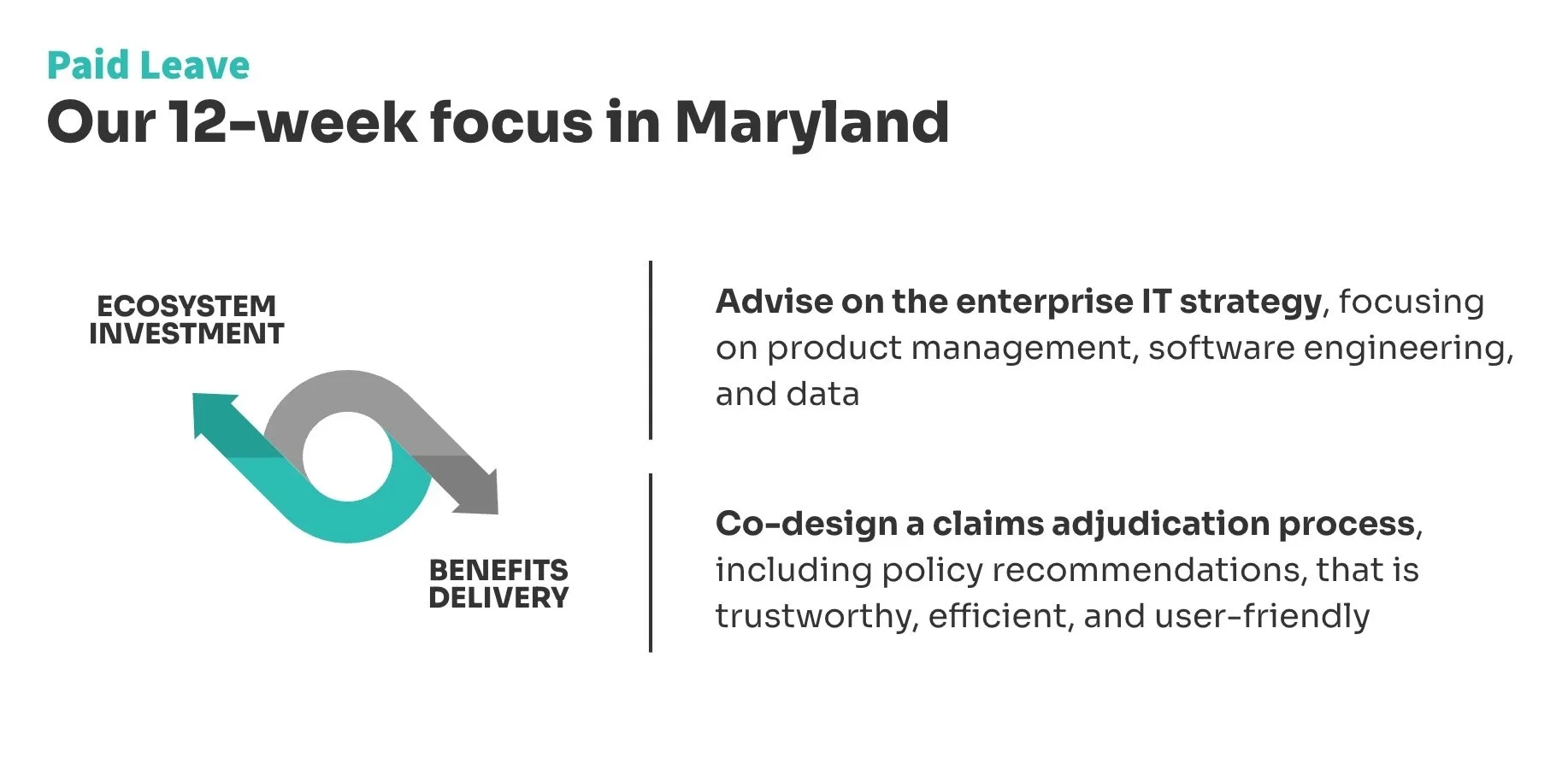Advising paid family and medical leave program development in Maryland
July 2023 - September 2023
Maryland Department of Labor
Why This Matters For Families
In 2022, Maryland passed a paid family and medical leave program, joining a dozen other states that have adopted a similar program to ensure job protections and provide income support to families when managing a major event in their lives. Whether it’s the arrival of a new child or diagnosis of an illness, paid leave supports families by offering them financial support when they need time to care. Paid leave is associated with higher labor force participation rates, higher earnings over time, better health, worker retention and productivity, and economic growth.
The New Practice Lab team is working directly with state administrators, as well as the individuals and families whom they serve, to streamline state paid leave program benefits. The team has also offered guidance to states working to pass paid family and medical leave laws, offering advice on language and processes that will aid benefit delivery to claimants and families. These programs can provide critical relief to U.S. families — but only if they reach the people who need them, when they need them.
Implementation Challenge
When seeking paid leave, workers must file a claim with the state in order to be deemed eligible and access the benefit. However, this becomes a complex determination for states, given the number of potential uses of paid leave, and the duration of leave that these policies cover.
Before the Family and Medical Leave Insurance (FAMLI) program in Maryland began dispensing benefits, the New Practice Lab worked with the team to help understand and research what a claims adjudication process could look like that served both the FAMLI staff and claimants.
Diagram of how processes are claimed
Our Approach
The New Practice Lab engaged in a 12-week sprint with Maryland’s FAMLI team, wherein lab members met weekly with MD FAMLI leadership to understand the evolving state of the paid leave program, and conduct learning sessions on potential adjudication workflows.
The team also conducted interviews and held information-gathering sessions with paid leave officials, external experts and stakeholders, as well as paid leave officials in New Jersey, Massachusetts, Washington, and the District of Columbia (DC). There were also two site visits in the state of Washington and DC. We solicited input from paid leave advocates to improve our understanding of the medical certification process, and conducted desk research to contextualize our findings of the landscape.
Our 12-week focus in Maryland
ORIGINAL OBJECTIVE
Understand the different approaches to internal case management systems and their impacts on user and agency experience
WHAT WE DID
Interviewed and went on-site with states currently running paid leave programs to understand the workload and training needs required for care-based, task-based, and hybrid systems to understand the pros and cons of each.
ORIGINAL OBJECTIVE
Understand the eligibility and verification processes of submitting paid leave
WHAT WE DID
Assisted Maryland in mapping the options of identity verification and various FAMILI-eligible leave scenarios.
Developed insights to improve the medical certification process and employer notification requirements.
ORIGINAL OBJECTIVE
Understand the enterprise strategy needed for product management, software engineering, and data science
WHAT WE DID
Outlined the data model stages necessary to build a paid leave program from the ground up.
Developed recommendations for ongoing project management and technology improvement.
Identified data security measures to ensure the security of the application process.
What We Learned
Data systems and data collection practices should be designed with both members of the public and public servants in mind.
All data collection decisions should balance the state policy and data teams’ need for comprehensive information against the burden that this places on claimants. Data scientists, policy experts, claims examination staff, and UX designers should work together to decide what information is gathered from members of the public, how that information is gathered, and how it is used.
FAMLI should devote time and energy to designing the medical certification process.
Medical certifications are a significant source of delay for existing paid leave systems. While many aspects of medical certification are entirely out of the program’s control, good form design and tactical policy guidance can still significantly improve the process. Policy experts, claims examiners, and UX designers should collaborate to design an efficient and effective medical certification process.
Automation should be approached thoughtfully, with a high degree of transparency for claimants.
Automatically completing eligibility checks offers significant efficiencies for paid leave programs, but also creates risk of inaccurately denying eligible claimants. To prevent this, the system should be transparent about what information is used for automated eligibility determinations and how that information is used. This will allow claimants to understand how eligibility is determined, quickly identify inaccurate data, and make appropriate redetermination requests.
Next Steps
The Maryland FAMLI program will begin dispensing benefits in 2028, and the New Practice Lab team was able to identify priority areas for workflow and implementation development, including work on the medical certification process.









